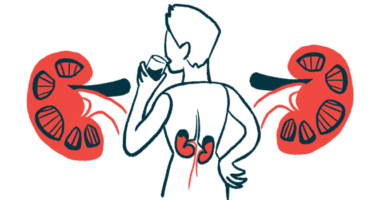Creatinine levels, biopsy predict AAV kidney failure risk, study finds
Plasma exchange had no effect on kidney failure progression or recovery

High blood creatinine levels and results from kidney biopsies at the time of diagnosis were the best predictors of kidney failure risk in people with ANCA-associated vasculitis (AAV) with severe kidney disease, a study found.
Blood creatinine levels, a marker of kidney damage, and kidney biopsy findings also predicted kidney function recovery and the need for short- or long-term dialysis.
Plasma exchange (PLEX), a blood-cleaning procedure used in AAV to potentially remove disease-driving self-reactive antibodies from circulation, was found to have no significant effect on kidney failure risk or recovery, according to the study.
“Kidney recovery, dialysis discontinuation, and [kidney failure progression] in patients with [severe kidney disease] depended on [blood creatinine levels] and … findings on kidney biopsies at the time of diagnosis and was not affected by the addition of PLEX,” the researchers wrote.
The study, “Predictive Factors of Renal Recovery and Progression to End-Stage Kidney Disease in Patients with Antineutrophil Cytoplasmic Autoantibody-Associated Vasculitis with Severe Kidney Disease,” was published in the journal Kidney International Reports.
Kidney failure risk high for AAV patients
The risk of kidney failure, also called end-stage kidney disease (ESKD), is high among people with AAV, a group of autoimmune disorders characterized by inflammation and damage to small blood vessels. As many as 25% of AAV patients develop ESKD five years after disease onset.
Now, a team led by scientists at the Mayo Clinic College of Medicine set out to identify which clinical factors could predict kidney outcomes in AAV patients with severe kidney involvement due to active glomerulonephritis — inflammation and damage to glomeruli, which are the kidneys’ filtering units.
The team analyzed electronic medical records of 166 people with newly diagnosed or relapsing granulomatosis with polyangiitis (GPA) or microscopic polyangiitis (MPA), the two most common types of AAV. All patients tested positive for AAV-associated self-reactive antibodies, or ANCAs, against either the MPO or the PR3 enzymes.
The most common immunosuppressive treatments to induce the remission of AAV symptoms were intravenous or into-the-vein methylprednisolone, cyclophosphamide, and rituximab (marketed as Rituxan in the U.S., and available as biosimilars). In all, about 30% of patients received PLEX in addition to standard immunosuppressive induction treatment.
Most patients (78.9%) achieved remission within six months, and 83.4% saw remission during follow-up. Relapses occurred in 24.7%, and 75.6% of those were kidney relapses.
Nearly two-thirds of patients (63.9%) needed dialysis throughout follow-up. By the end of follow-up, 59 patients (35.5%) had died, with active AAV as the cause in 16 of them.
Of the 150 patients still alive during the first year of follow-up, 50 (33.3%) reached ESKD. Patients progressing to kidney failure had significantly higher blood creatinine levels and worse kidney function, as reflected by a lower glomerular filtration rate (eGFR), at diagnosis.
They also had more signs of kidney damage on biopsy at diagnosis, were less commonly treated with rituximab, and were less likely to experience relapses during that year. By the end of follow-up, more ESKD patients had died than those without ESKD (40% vs. 23%).
Results after 1 year show improved kidney function for some patients
In turn, about half of all patients alive at one year showed improved kidney function, as indicated by an eGFR increase. Those experiencing improvements within 12 months had higher eGFR, or better kidney function, at diagnosis, minimal or milder kidney damage on biopsy, and were less likely to experience relapses.
A total of 71 patients started dialysis within the first four weeks of diagnosis, with 27 (38%) discontinuing because of kidney function recovery after treatment.
Most patients needing short-term dialysis had lower creatinine levels, higher eGFR values, and minimal or mild biopsy-assessed kidney damage at diagnosis. Also, significantly more of these patients had GPA relative to MPA (63% vs. 38.6%).
Conversely, the 44 patients (62%) who remained dialysis-dependent at 12 months had higher creatinine and more severe kidney damage on biopsy at diagnosis.
In the group of patients starting early dialysis, 53% received cyclophosphamide and 40.9% rituximab. There were no significant differences between these groups in terms of frequency of kidney recovery, the need for dialysis, ESKD at 12 months, or infections. However, significantly more patients on cyclophosphamide experienced relapses (42.9% vs. 7.4%) and died (51.4% vs. 25.9%).
About half in this patient group received PLEX. But this approach did not influence time to kidney failure, and ESKD rates were similar between the group given PLEX and those who were not.
Adding PLEX to standard induction therapy did not appear to prevent ESKD at 12 months, “with the incidence of ESKD at 12 months being higher in patients who received PLEX,” the team wrote. It also did not influence rates of patients showing kidney function recovery.
“Our study suggests that response to treatment in severe [AAV-related glomerulonephritis] depends on [creatinine] and histologic findings on kidney biopsies at the time of diagnosis, regardless of PLEX,” the researchers wrote.







